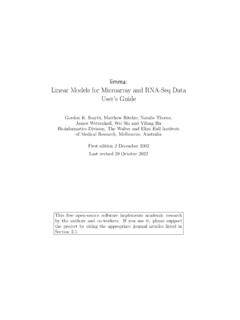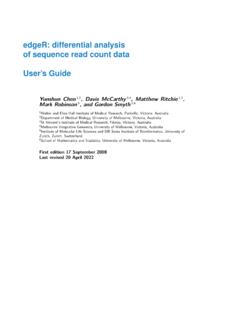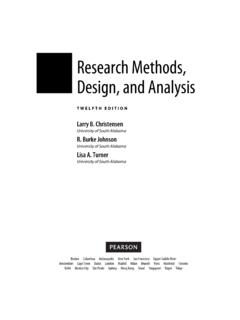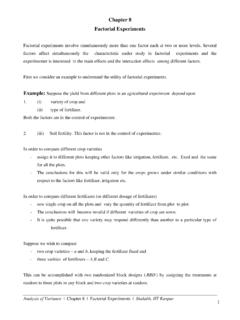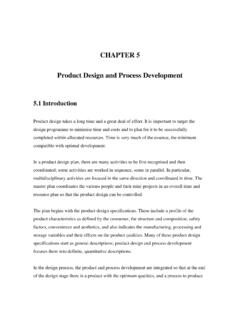Transcription of limma Linear Models for Microarray and RNA-Seq Data …
1 limma : Linear Models for Microarray and RNA-Seq DataUser s GuideGordon K. Smyth, Matthew Ritchie, Natalie Thorne,James Wettenhall, Wei Shi and Yifang HuBioinformatics Division, The Walter and Eliza Hall Instituteof Medical Research, Melbourne, AustraliaFirst edition 2 December 2002 Last revised 14 November 2021 This free open-source software implements academic researchby the authors and co-workers. If you use it, please supportthe project by citing the appropriate journal articles listed inSection Introduction52 Citinglimma.. Installation .. How to get help ..93 Quick A brief introduction to R .. SamplelimmaSession .. Data Objects .. 134 Reading Microarray Scope of this chapter .. Recommended Files .. The Targets Frame .. Reading Two-Color Intensity Data .. Reading Single-Channel Agilent Intensity Data .. Reading Illumina BeadChip Data .. Image-derived Spot Quality Weights.
2 Reading Probe Annotation .. Printer Layout .. The Spot Types File .. 225 Quality Assessment246 Pre-Processing Two-Color Background Correction .. Within-Array Normalization .. Between-Array Normalization .. Using Objects from the marray Package .. 337 Filtering unexpressed probes3418 Linear Models Introduction .. Single-Channel Designs .. Common Reference Designs .. Direct Two-Color Designs .. 399 Single-Channel Experimental Introduction .. Two Groups .. Several Groups .. Additive Models and Blocking .. Samples .. Interaction Models : 2 2 Factorial Designs .. of Interest .. as for a Single Factor .. Nested Interaction Formula .. Interaction Models .. Time Course Experiments .. time points .. time points .. Multi-level Experiments .. 5010 Two-Color Experiments with a Common Introduction.
3 Two Groups .. Several Groups .. 5411 Direct Two-Color Experimental Introduction .. Simple Comparisons .. Replicate Arrays .. Dye Swaps .. A Correlation Approach to Technical Replication .. 5712 Separate Channel Analysis of Two-Color Data5913 Statistics for Differential Summary Top-Tables .. Fitted model Objects .. Multiple Testing Across Contrasts .. 6314 Array Quality Introduction .. Example 1 .. Example 2 .. When to Use Array Weights .. 69215 RNA-Seq Introduction .. Making a count matrix .. Normalization and filtering .. Differential expression: limma -trend .. Differential expression: voom .. Voom with sample quality weights .. Differential splicing .. 7416 Two-Color Case Swirl Zebrafish: A Single-Group Experiment .. Apoa1 Knockout Mice: A Two-Group Common-Reference Experiment .. Weaver Mutant Mice: A Composite 2x2 Factorial Experiment.
4 Background .. Sample Preparation and Hybridizations .. Data input .. Annotation .. Quality Assessment and Normalization .. Setting Up the Linear model .. Probe Filtering and Array Quality Weights .. Differential expression .. Bob1 Mutant Mice: Arrays With Duplicate Spots .. 9517 Single-Channel Case Lrp MutantE. ColiStrain with Affymetrix Arrays .. Background .. Downloading the data .. Background correction and normalization .. Gene annotation .. Differential expression .. Effect of Estrogen on Breast Cancer Tumor Cells: A 2x2 Factorial Experiment withAffymetrix Arrays .. Comparing Mammary Progenitor Cell Populations with Illumina BeadChips .. Introduction .. The target RNA samples .. The expression profiles .. How many probes are truly expressed? .. Normalization and filtering .. Within-patient correlations .. Differential expression between cell types.
5 Signature genes for luminal progenitor cells .. Time Course Effects of Corn Oil on Rat Thymus with Agilent 4x44K Arrays .. Introduction .. Data availability .. Reading the data .. Gene annotation .. Background correction and normalize .. Gene filtering .. Differential expression .. Gene ontology analysis .. 11718 RNA-Seq Case Profiles of Yoruba HapMap Individuals .. Background .. Data availability .. Yoruba Individuals and FASTQ Files .. Mapping reads to the reference genome .. Annotation .. DGEList object .. Filtering .. Scale normalization .. Linear modeling .. Gene set testing .. Session information .. Acknowledgements .. Differential Splicing after Pasilla Knockdown .. Background .. GEO samples and SRA Files .. Mapping reads to the reference genome .. Read counts for exons .. Assemble DGEList and sum counts for technical replicates .. Gene annotation.
6 Filtering .. Scale normalization .. Linear modelling .. Alternate splicing .. Session information .. Acknowledgements .. 1444 chapter 1 IntroductionLimmais a package for the analysis of gene expression data arising from Microarray or RNA-seqtechnologies [32]. A core capability is the use of Linear Models to assess differential expression inthe context of multifactor designed the ability to analyze comparisonsbetween many RNA targets simultaneously. It has features that make the analyses stable even forexperiments with small number of arrays this is achieved by borrowing information across genes. Itis specially designed for analysing complex experiments with a variety of experimental conditions andpredictors. The Linear model and differential expression functions are applicable to data from anyquantitative gene expression technology including microoarrays, RNA-Seq and quantitative handle both single-channel and two-color guide gives a tutorial-style introduction to the mainlimmafeatures but does not describeevery feature of the package.
7 A full description of the package is given by the individual func-tion help documents available from the R online help system. To access the online help, typehelp(package= limma )at the R prompt or else start the html help system ()or theWindows drop-down help a strong suite of functions for reading, exploring and pre-processing data fromtwo-color microarrays. The Bioconductor packagemarrayprovides alternative functions for readingand normalizing spotted two-color Microarray data. Themarraypackage provides flexible locationand scale normalization routines for log-ratios from two-color arrays. Thelimmapackage overlapswithmarrayin functionality but is based on a more general concept of within-array and between-arraynormalization as separate steps. If you are usinglimmain conjunction withmarray, see Section read output data from a variety of image analysis software platforms, includingGenePix, ImaGene etc. Either one-channel or two-channel formats can be Bioconductor packageaffyprovides functions for reading and normalizing Affymetrix mi-croarray data.
8 Advice on how to uselimmawith theaffypackage is given throughout the User sGuide, see for example Section and theE. coliand estrogen case for reading and pre-processing expression data from Illumina BeadChips were intro-duced See the case study in Section for an example of also beused in conjunction with thevstorbeadarraypackages for pre-processing Illumina version ,limmaincludes functions to analyse RNA-Seq experiments, demonstratedin Case Study The approach is to convert a table of sequence read counts into an expressionobject which can then be analysed as for Microarray guide describeslimmaas a command-driven package. Graphical user interfaces to the mostcommonly used functions inlimmaare available through the packageslimmaGUI[47], for two-color5data, oraffylmGUI[46], for Affymetrix data. Both packages are available from user s guide should be correct for R Versions through andlimmaversions Thelimmahomepage CitinglimmaLimmaimplements a body of methodological research by the authors and co-workers.
9 Please try tocite the appropriate papers when you use results from thelimmasoftware in a publication, as suchcitations are the main means by which the authors receive professional credit for their limma software package itself can be cited as:Ritchie, ME, Phipson, B, Wu, D, Hu, Y, Law, CW, Shi, W, and Smyth, GK (2015). limma powers differential expression analyses for RNA-sequencing and Microarray Acids Research43(7), above article reviews the overall capabilities of the limma package, both new and articles describe the statistical methodology behind particular functions of the package. Ifyou uselimmafor differential expression analysis, please cite:Phipson, B, Lee, S, Majewski, IJ, Alexander, WS, and Smyth, GK (2016). Robusthyperparameter estimation protects against hypervariable genes and improves power todetect differential of Applied Statistics10(2), 946 article describes the Linear modeling approach implemented bylmFitand the empirical Bayesstatistics implemented byeBayes,topTableetc.
10 It particularly describeseBayeswithrobust=TRUE ortrend= you uselimmafor RNA-Seq analysis, please cite either:Law, CW, Chen, Y, Shi, W, and Smyth, GK (2014). Voom: precision weights unlocklinear model analysis tools for RNA-Seq read Biology15, , R, Holik, AZ, Su, S, Jansz, N, Chen, K, Leong, HS, Blewitt, ME, Asselin-Labat,M-L, Smyth, GK, Ritchie, ME (2015). Why weight? Modelling sample and observationallevel variability improves power in RNA-Seq Acids Research43, et al (2014) describe the voom and limma -trend pipelines for RNA-Seq , while Liu et al (2015)describe you uselimmawith duplicate spots or technical replication, please cite7 Smyth, G. K., Michaud, J., and Scott, H. (2005). The use of within-array replicate spotsfor assessing differential expression in Microarray , 2067 above article describes the theory behind you uselimmafor normalization of two-color Microarray data, please cite one of:Smyth, G. K., and Speed, T. P. (2003). Normalization of cDNA Microarray , 265 , A.

